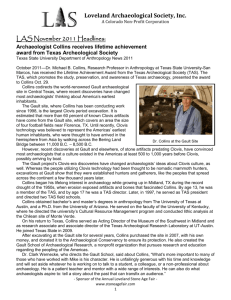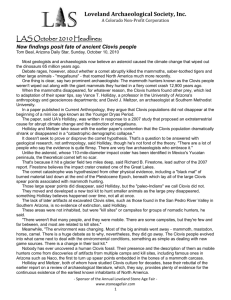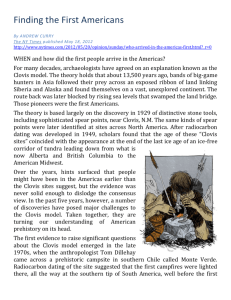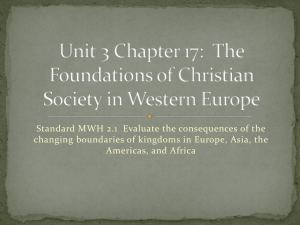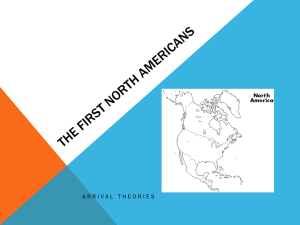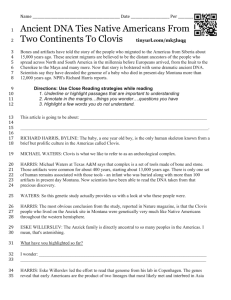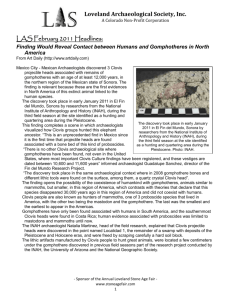December 2009 Monthly Newsletter
advertisement
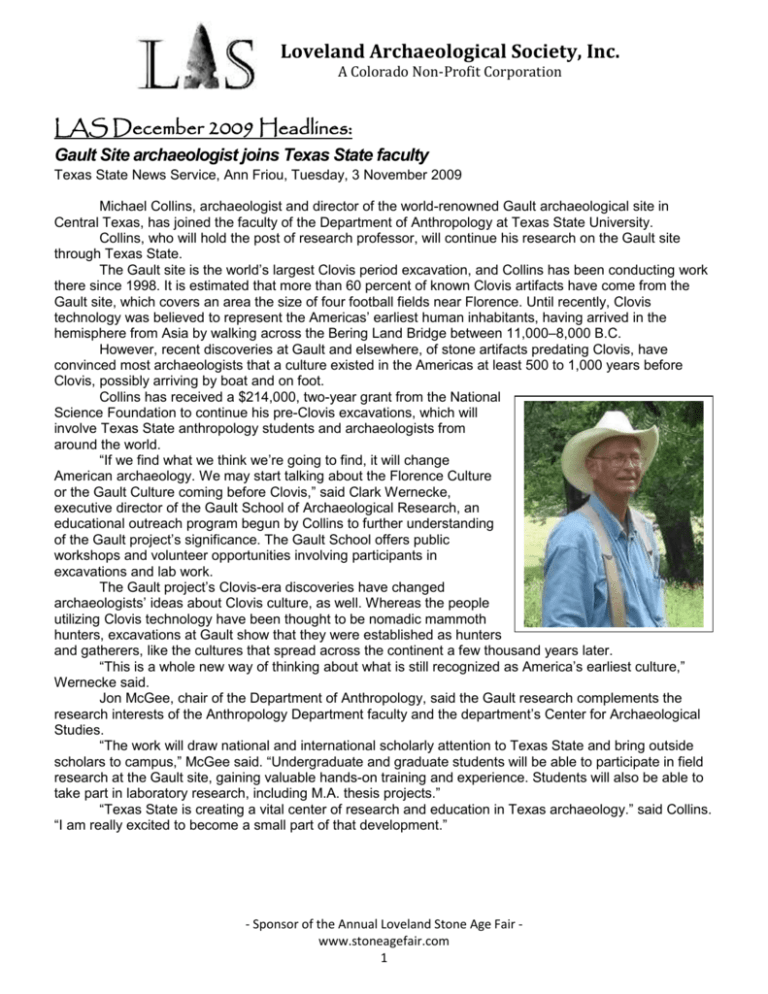
Loveland Archaeological Society, Inc. A Colorado Non-Profit Corporation LAS December 2009 Headlines: Gault Site archaeologist joins Texas State faculty Texas State News Service, Ann Friou, Tuesday, 3 November 2009 Michael Collins, archaeologist and director of the world-renowned Gault archaeological site in Central Texas, has joined the faculty of the Department of Anthropology at Texas State University. Collins, who will hold the post of research professor, will continue his research on the Gault site through Texas State. The Gault site is the world’s largest Clovis period excavation, and Collins has been conducting work there since 1998. It is estimated that more than 60 percent of known Clovis artifacts have come from the Gault site, which covers an area the size of four football fields near Florence. Until recently, Clovis technology was believed to represent the Americas’ earliest human inhabitants, having arrived in the hemisphere from Asia by walking across the Bering Land Bridge between 11,000–8,000 B.C. However, recent discoveries at Gault and elsewhere, of stone artifacts predating Clovis, have convinced most archaeologists that a culture existed in the Americas at least 500 to 1,000 years before Clovis, possibly arriving by boat and on foot. Collins has received a $214,000, two-year grant from the National Science Foundation to continue his pre-Clovis excavations, which will involve Texas State anthropology students and archaeologists from around the world. “If we find what we think we’re going to find, it will change American archaeology. We may start talking about the Florence Culture or the Gault Culture coming before Clovis,” said Clark Wernecke, executive director of the Gault School of Archaeological Research, an educational outreach program begun by Collins to further understanding of the Gault project’s significance. The Gault School offers public workshops and volunteer opportunities involving participants in excavations and lab work. The Gault project’s Clovis-era discoveries have changed archaeologists’ ideas about Clovis culture, as well. Whereas the people utilizing Clovis technology have been thought to be nomadic mammoth hunters, excavations at Gault show that they were established as hunters and gatherers, like the cultures that spread across the continent a few thousand years later. “This is a whole new way of thinking about what is still recognized as America’s earliest culture,” Wernecke said. Jon McGee, chair of the Department of Anthropology, said the Gault research complements the research interests of the Anthropology Department faculty and the department’s Center for Archaeological Studies. “The work will draw national and international scholarly attention to Texas State and bring outside scholars to campus,” McGee said. “Undergraduate and graduate students will be able to participate in field research at the Gault site, gaining valuable hands-on training and experience. Students will also be able to take part in laboratory research, including M.A. thesis projects.” “Texas State is creating a vital center of research and education in Texas archaeology.” said Collins. “I am really excited to become a small part of that development.” - Sponsor of the Annual Loveland Stone Age Fair www.stoneagefair.com 1 Loveland Archaeological Society, Inc. A Colorado Non-Profit Corporation Prehistoric man, giant animal coexisted By Tom Beal, Arizona Daily Star, Tucson, Arizona | Published: 11.16.2009 The secret is out: Man and gomphotheres once coexisted in Sonora. Tools and spear tips found with fossil bones at a remote Sonoran site suggest that Clovis-era hunters butchered two juvenile specimens of the elephantlike megafauna about 13,000 years ago. It's the first discovery of such recent evidence of gomphotheres in North America, said Vance Holliday, a University of Arizona anthropologist. It's also the first time gomphothere fossils were found An archaeological crew works at the Rio Sonora together with implements made by Clovis people, the excavation site, which has yielded gomphothere oldest known inhabitants of North America, Holliday fossils, and tools and spear tips that are likely said. more than 12,000 years old. The discovery, on a remote ranch in the Rio Sonora watershed, was actually made in 2007 but was kept quiet to avoid alerting fossil hunters to it. Archaeologists from Mexico and the United States named the site "El Fin del Mundo," or "The End of the World." They continue to work the site in the Mexican state that borders Arizona but presented some preliminary findings last month at a Geological Society of America meeting in Portland, Ore. Holliday said Guadalupe Sanchez of Mexico's national institute of anthropology was originally taken to the site by a rancher who had discovered large bones in an arroyo. Holliday said he was unsure if Clovis people were hunting gomphotheres or scavenging them. In either case, Holliday said, "this would be the first documentation that there was some sort of human interaction with gomphotheres in North America." Holliday said the international team of archaeologists from the UA and the Instituto Nacional de Antropología e Historia in Mexico City expect to complete excavation of the site this winter. Archaeologists have yet to find human fossil evidence of the culture they call Clovis, named for Clovis, N.M., where scientists uncovered the first distinctive spear tips from a period about 13,000 years ago. The San Pedro Valley has since proved to be a fertile area for Clovis investigation. At the most famous site, Murray Springs near Sierra Vista, scientists uncovered spear tips among the bones of mammoths, leading them to postulate that the Clovis people hunted the megafauna that once populated a wetter, milder Southwest in the Ice Age — possibly hunting the mammoths to extinction. The Murray Springs site also contained bones of several other North American megafauna, as well as tools and a hearth. Now, scientists might be able to add the elephantlike gomphotheres to the list of Clovis prey. Gomphotheres were thought to have vanished from North America 100,000 years ago, said David Lambert, a biologist at the Louisiana School of Science, Mathematics and the Arts. "This is a Lazarus effect," he said. "Something disappears and then, out of the blue, pops up again." Lambert, who has unearthed three gomphotheres in Florida — all more than 120,000 years old — said "this discovery is certainly a surprise." There are a variety of gomphotheres — some with crocodile-like jaws and four tusks. The one that populated North America is called Cuvieronius and is about the size of an Asian elephant and elephantlike in appearance, Lambert said. Holliday is executive director of the Argonaut Archaeological Research Fund, which searches for evidence of the earliest paleo-Indian habitation of the Southwest. - Sponsor of the Annual Loveland Stone Age Fair www.stoneagefair.com 2 Loveland Archaeological Society, Inc. A Colorado Non-Profit Corporation Holliday said archaeologists expect the Rio Sonora area, the south drainage of the watershed that feeds the San Pedro, to yield more evidence of Clovis habitation. The Fin del Mundo site, which he says is more than 12,000 years old, also includes an extensive Clovis encampment, he said. "It was a pristine site; nobody had ever been there to collect, probably just due to the remoteness of it. It was astonishing the number of artifacts on the surface," Holliday said. - Sponsor of the Annual Loveland Stone Age Fair www.stoneagefair.com 3 Loveland Archaeological Society, Inc. A Colorado Non-Profit Corporation LAS Find of the Month, December 2009: Members in good standing can bring an artifact to be entered into the competition at the monthly meeting, which will be judged based on the following rules: Must be a member of LAS in good standing. The artifact must be a personal find. It must have been found within the specified time frame, i.e., within the month prior to the meeting. The artifact doesn’t have to be a Colorado find—all that matters is that it was found in the last month. The winner for December 2009 was Karla Kampbell Type: Hanna Material: Flattop Chalcedony Location: South Platte River near Big Springs, Nebraska Photo: (scale in centimeters) LAS News and Upcoming Events: December 1st December meeting. Our annual Christmas party was a great event. If you couldn’t attend you missed a class act. A hearty “THANK YOU” goes out to all who brought a dish or beverage, and to those who brought a donation for our local Native American families. You helped make this a MERRY CHRISTMAS for many families. See the Minutes section for 2010 LAS officer election results. January 5th, 2010 January meeting. Guest speaker: Pam Whelden. Pam will get us ready for the new year by telling us about “Other Artifacts” from the eastern plains of Colorado. Book Offer The 2009 Loveland Stone Age Fair commemorative book is now available for purchase. If you’d like a copy talk to Andy Coca or Sharon Lundt at the next meeting. If you can’t be at the January 2010 meeting, we’ll have more information in the next newsletter on the price and how to order. - Sponsor of the Annual Loveland Stone Age Fair www.stoneagefair.com 4
